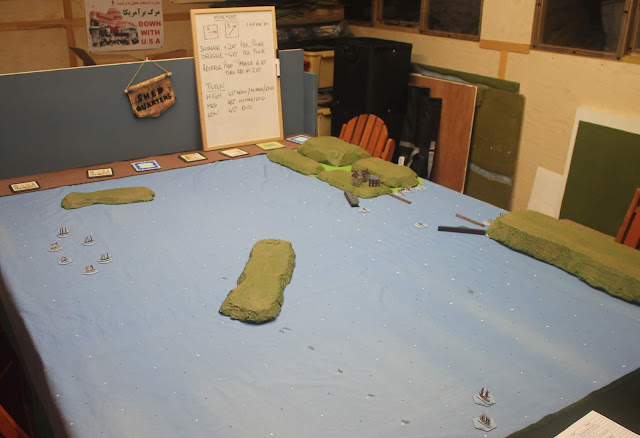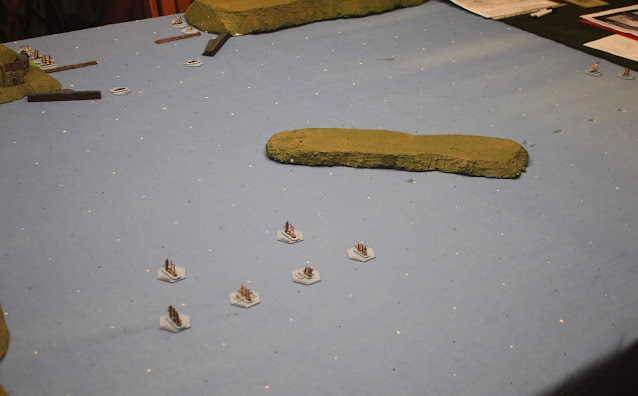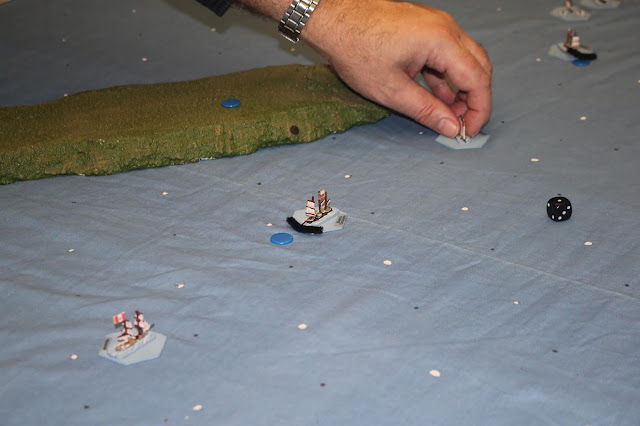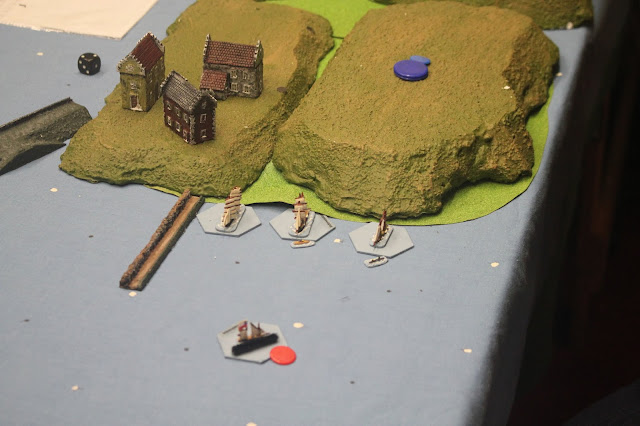As promised last week we had a return to the Pacific War Naval Campaign. The late 19th century one, not the 20th century one with the aircraft carriers. Thought I'd better make that clear from the start.
Because I'm me there was very little chance that the rules as published would make it unscathed into a second week.
For this game I made some changes to the movement system, by introducing squares. Movement is now based on the number of Knots a vessel is moving, and it takes 2 Knots to cross a square orthogonally, or 3 diagonally. I also introduced a random reloading mechanism and tweaked the factors for gunnery. The latter presages a major re-write to the combat system, most likely.
This one was also a scenario based game. The Chileans have heard that the Peruvians have put together a sizeable troop carrying fleet in the harbour, and also that one of the Peruvian ironclads is in for a refit. They therefore plan to launch spar torpedo boats into the harbour to sink as many as possible.
This gave me a chance to deploy the Peruvian monitors which usually stay in the box. Coincidentally with the attack the Huascar and the Union were returning to their home port.
The port was improvised from bits of my 6mm Vauban fortress to make harbour walls and docking facilities.
As the Chileans arrive the torpedo boats are being transported by two steam sloops to save their engines and stop them being swamped in deep waters.
I was expecting 3 players, and Patrick, Richard and Steve were soon on site and listening intently to the briefing. Patrick turned up because Chris A has been nagging him about playing an Ironclad game
They were shortly followed by Phil & Chris A, so we had a pretty full house. Patrick was prepared to be fully involved having committed to an Ironclad game, and was aggressively advancing his flotilla which protected the Port side of the Chilean fleet.
Steve opened fire with both of the monitors, which were anchored as port guards.
The ships start to close in on one another. The blue chips mark unspent "Knots". You can carry 2 points forward if you can't spend them, otherwise diagonal movement becomes much slower. I was worried it would make the play a bit "jerky"but in the end it worked fine.
The Blanco Encalada and the Huascar picked up from last week. I have to say that the shooting in this game was even worse than before. There was some shockingly poor dice rolling by both sides.
I'd put an incentive in the rules for the ships to hold fire and close the range, and the players duly obliged. The red chip indicates that the Huascar has been shot up by Gatling Guns. This needs looking at, as her gun crew are in an enclosed turret, so unlikely to be bothered by machine gun fire.
The Blanco Encalada sails past the Huascar, whilst a smaller Chilean ship (the Pilcomayo, I think) closes in to take advantage of the slow loading speed of the Huascar. Each ship has a loading value for its guns. You roll a d6 each phase and when you exceed the loading total you can fire again.
Richard finally unleashes the first wave of torpedo boats, who speed fearlessly into the harbour.
They are swiftly followed by the second wave of boats.
Gatling gun fire from the Huascar, bottom right, forces one of the boats off track, and she heads towards the Manco Capac monitor.
Followed by the Covadonga (why, Richard? why?) two boats pick out targets, with mixed success.
The boat attacking the Independencia survives raking Gatling Gun fire, but loses the torpedo spar in the attack. The other boat collides and detonates the torpedo on a medium sized transport. It starts to take on water (green markers).
The Huascar follows into the harbour to try and drive off the attackers. The torpedo boats rapidly try to reload.
Outside the Almirante Cochrane narrowly avoids sailing into the harbour wall. The other vessels whirl around each other firing as soon as they can. At the top of the picture the torpedo attack on the Manco Capac has detonated, and caused flooding. Somewhere around here, as well, Phil tried to ram an opponent then board her. It all went wrong.
The Huascar succeeds in machine gunning one of the torpedo boats which has just hit another transport. The Gatling Guns rip the little boat to shreds and she goes to the bottom. The Chileans have done quite a bit of damage with the little boats, which is more than can be said for the firing with the big guns. We never got anything more than a Light Damage hit from them all evening.
We had to call it a day then, as time was getting on. Looks like a Chilean victory, but I fear that the boats that have gone into the harbour will be hunted down by the Huascar and destroyed. The Independencia has survived unscathed.
It all provided entertainment for an evening for the 6 of us. The modifications worked well, and I will stick with them (need more dots on the cloth, however), and I will look further at the firing rules and how the critical hits work. It would be true to say that this isn't everyone's warm beverage of choice. I would happily play them some more, especially after I've done more work on them as there are things in them that I would not do from a design point of view. That doesn't mean they're bad rules, - it's just that there are things I would not do in a set of rules. An example of this from another set is that I would never use PIPs. Doesn't mean they're a bad idea, it's just I wouldn't use them.
Any how, I think they may go away for a few weeks. My next development project is calling. I must start to sort out "Taiping Era" for publication, and I need to do something with the game system for my 6mm Edgcote prior to Joy of Six. It's all go, isn't it?
Because I'm me there was very little chance that the rules as published would make it unscathed into a second week.
For this game I made some changes to the movement system, by introducing squares. Movement is now based on the number of Knots a vessel is moving, and it takes 2 Knots to cross a square orthogonally, or 3 diagonally. I also introduced a random reloading mechanism and tweaked the factors for gunnery. The latter presages a major re-write to the combat system, most likely.
This one was also a scenario based game. The Chileans have heard that the Peruvians have put together a sizeable troop carrying fleet in the harbour, and also that one of the Peruvian ironclads is in for a refit. They therefore plan to launch spar torpedo boats into the harbour to sink as many as possible.
This gave me a chance to deploy the Peruvian monitors which usually stay in the box. Coincidentally with the attack the Huascar and the Union were returning to their home port.
The port was improvised from bits of my 6mm Vauban fortress to make harbour walls and docking facilities.
As the Chileans arrive the torpedo boats are being transported by two steam sloops to save their engines and stop them being swamped in deep waters.
I was expecting 3 players, and Patrick, Richard and Steve were soon on site and listening intently to the briefing. Patrick turned up because Chris A has been nagging him about playing an Ironclad game
They were shortly followed by Phil & Chris A, so we had a pretty full house. Patrick was prepared to be fully involved having committed to an Ironclad game, and was aggressively advancing his flotilla which protected the Port side of the Chilean fleet.
Steve opened fire with both of the monitors, which were anchored as port guards.
The ships start to close in on one another. The blue chips mark unspent "Knots". You can carry 2 points forward if you can't spend them, otherwise diagonal movement becomes much slower. I was worried it would make the play a bit "jerky"but in the end it worked fine.
The Blanco Encalada and the Huascar picked up from last week. I have to say that the shooting in this game was even worse than before. There was some shockingly poor dice rolling by both sides.
I'd put an incentive in the rules for the ships to hold fire and close the range, and the players duly obliged. The red chip indicates that the Huascar has been shot up by Gatling Guns. This needs looking at, as her gun crew are in an enclosed turret, so unlikely to be bothered by machine gun fire.
The Blanco Encalada sails past the Huascar, whilst a smaller Chilean ship (the Pilcomayo, I think) closes in to take advantage of the slow loading speed of the Huascar. Each ship has a loading value for its guns. You roll a d6 each phase and when you exceed the loading total you can fire again.
Richard finally unleashes the first wave of torpedo boats, who speed fearlessly into the harbour.
They are swiftly followed by the second wave of boats.
Gatling gun fire from the Huascar, bottom right, forces one of the boats off track, and she heads towards the Manco Capac monitor.
Followed by the Covadonga (why, Richard? why?) two boats pick out targets, with mixed success.
The boat attacking the Independencia survives raking Gatling Gun fire, but loses the torpedo spar in the attack. The other boat collides and detonates the torpedo on a medium sized transport. It starts to take on water (green markers).
The Huascar follows into the harbour to try and drive off the attackers. The torpedo boats rapidly try to reload.
Outside the Almirante Cochrane narrowly avoids sailing into the harbour wall. The other vessels whirl around each other firing as soon as they can. At the top of the picture the torpedo attack on the Manco Capac has detonated, and caused flooding. Somewhere around here, as well, Phil tried to ram an opponent then board her. It all went wrong.
The Huascar succeeds in machine gunning one of the torpedo boats which has just hit another transport. The Gatling Guns rip the little boat to shreds and she goes to the bottom. The Chileans have done quite a bit of damage with the little boats, which is more than can be said for the firing with the big guns. We never got anything more than a Light Damage hit from them all evening.
We had to call it a day then, as time was getting on. Looks like a Chilean victory, but I fear that the boats that have gone into the harbour will be hunted down by the Huascar and destroyed. The Independencia has survived unscathed.
It all provided entertainment for an evening for the 6 of us. The modifications worked well, and I will stick with them (need more dots on the cloth, however), and I will look further at the firing rules and how the critical hits work. It would be true to say that this isn't everyone's warm beverage of choice. I would happily play them some more, especially after I've done more work on them as there are things in them that I would not do from a design point of view. That doesn't mean they're bad rules, - it's just that there are things I would not do in a set of rules. An example of this from another set is that I would never use PIPs. Doesn't mean they're a bad idea, it's just I wouldn't use them.
Any how, I think they may go away for a few weeks. My next development project is calling. I must start to sort out "Taiping Era" for publication, and I need to do something with the game system for my 6mm Edgcote prior to Joy of Six. It's all go, isn't it?


















Some interesting ideas there and the TD models are very nice too.
ReplyDeleteThanks. The new ideas worked well. The TD ships are excellent for their size. It can be a shade awkward distinguishing between them at a distance.
Delete